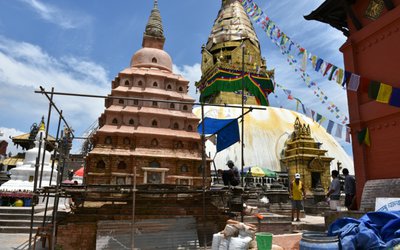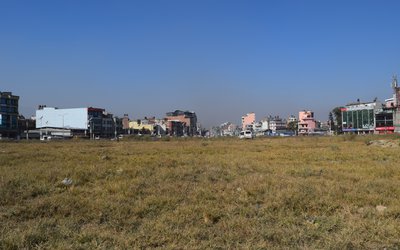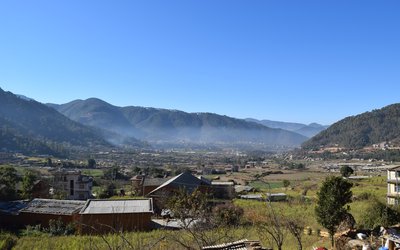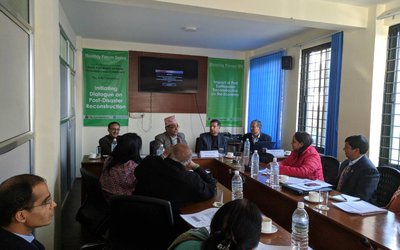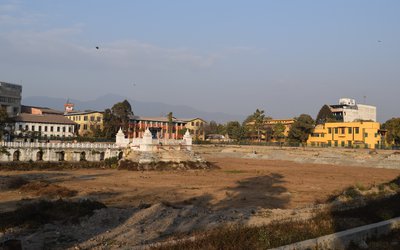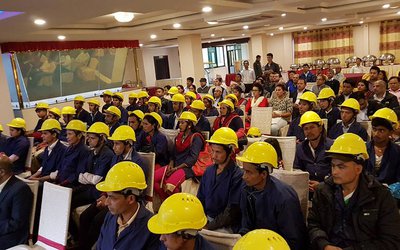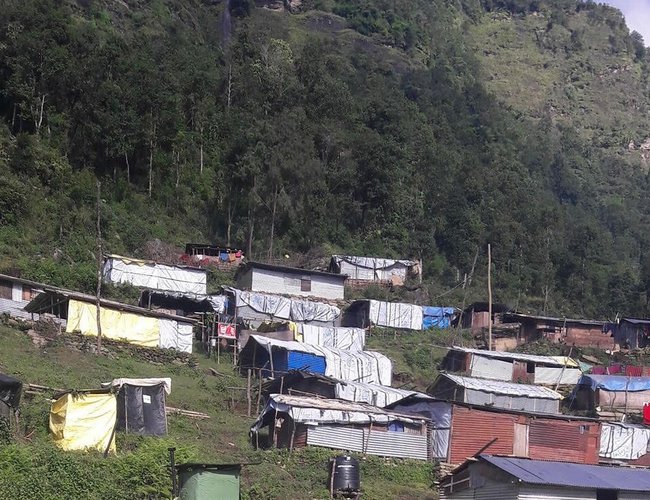
The face of Pashupati Thami, a member of the indigenous and marginalized Thami community, who has been living in a temporary shelter built with tarp sheets for the last 32 months, sees little hope of shifting to a new house anytime soon. As temperature in the village is dipping, she is frustrated and angry with the situation. When I met her in her home, she shared her pain in a matter of minute, without a breathing space.
“If nothing changes, what is the point of explaining my situation to everyone?” asked Thami. “Although I told my story to a number of people, nothing good has happened out of this yet.”Thami wore a pale face, showing uncertainty about her future.This is not a lone case. More than 70 households of previously Simpama, Ward No 1 of Bhimeshwor Municipality of Dolakha district, have been facing the same problems, living in temporary shelters, covered by tarpaulin, after the earthquakes of 2015 April and May.
Although their village turned from a Village Development Committee to Municipality, with elected representatives installed almost seven months ago, the common people are yet to find any respite.
As their land was washed away in a landslide, following earthquakes, and the remaining land cracked, they were relocated in open spaces of a community forest near their village. As landslides made their old settlement impossible to live, they were transferred here in search of a safe place to build their permanent shelter.
“There were a series of landslides beneath the mountains and upper hills,” said Thami. “The government then relocated us here to give us a permanent shelter.”
A few months after the earthquake, many donors visited the place to provide assistance, which included rice, salt, tarpaulin and clothes. Displaced populations of Besimpaka made the main news for the international media. This coverage generated hopes in the minds of people.
“With the wide international and national media coverage, our hopes to live in permanent shelters had gone high,” said sixty-nine-years-old Bahadur Thami. “Now, with fading coverage locally and internationally, nobody seems to be concerned about our trauma and difficulties. If we had shelters, we could manage food and clothes.”
Although these people in pain have been given small pieces of land to build their temporary shelters, they have to walk one and a half hours to their old shelters for grazing their cattle. They leave the temporary shelter early in the morning, with their cattle passing the fractured land, and return to their temporary shelters in the evening. This is their daily routine.
Although National Reconstruction Authority (NRA) has already taken a decision to shift the shelter of Simpama to a new place on the basis of the recommendations from a geological study, the process to transfer the shelter is yet to take off.
“We have been travelling to the district headquarters several times in the last two years to secure the land ownership certificate of the new land. However, NRA is yet to acquire the land,” said Kumar Thami, Chairman of Panipokhari Resettlement Committee. “We have been visiting government offices in the district. The government is yet to acquire the land for us. They are only raising hopes but no one is taking our case seriously. We are surviving merely on a dimming hope.”
“A number of national and international organizations have visited us and expressed support to build the shelters. However, everyone demands the land ownership certificate first. But we are homeless in effect, therefore, helpless as well.”
Why The Delay?
Although the Bosampa village is just 20 kilometers from Charikot, the district headquarters of Dolakha, and two hours’ walk, people are yet to get their permanent shelters.
As per the geological study conducted under the National Reconstruction Authority, the shelter of Bosampa village, earlier Ward No 1 of Chyamawati Village Development Committee, now Bhimeshwor Municipality Ward No 1, was declared geologically uninhabitable and unsafe for settlement. The study recommended relocation of the old settlement in a safe area.
However, Sagar Acharya, head of District Coordination Office of National Reconstruction Authority, said that the land registration process is at the last stage. “It will complete soon.”
However, victims hold different views. “We submitted the necessary documents to various district offices a long time back. But they have been saying the same words. Nothing has changed,” said Kumar Thami.
Acharya agrees that the pace of land registration process has been slow because of the delay in related work at the center. “The victims don’t need to worry. It is in the last stage,” said Acharya.
However, before transferring the settlement, Urban Development Division Office has to build infrastructure, including road, drinking water and electricity. Although the road construction started last year, it is still incomplete. “We demanded 70 million rupees to construct infrastructure. However, the government has allocated 30 million rupees. It was insufficient to develop the area for resettlement,” said Yek Raj Adhikari, head of Dolakha Division Office of Urban Development and Building Construction. “It will be easier for us if we work in coordination with other district level offices. However, it is still uncertain how to go about it?”
Victims have been living in temporary shelters for the third winter. The construction of the houses was delayed earlier because of problems at the district level and now it is getting delayed because of the problems at the center. “Hopefully, we may start the work at the end of December,” said Adhikari.
Less Discussion
Since the last one year, elections have been held for three tiers of government, including local level, provincial level and Center. Victims were tired of telling their problems to the candidates of all three levels. Victims have also been sharing their woes with donors and journalists.
Despite the many assurances of the candidates in their populist slogans, the plight of the displaced victims of Ward No 1 of Bhimeshwor Municipality remains the same. During the election campaigns, dozens of candidates passed through Simpa Primary School, which is at the verge of collapse, singing sugar-coated slogans. After the elections, no sign of any change is there for the building.
Even the elected representatives of the local bodies are yet to visit the temporary shelters where the Thami people are living.
Deputy Mayor Kamala Basnet of Bhimishwor Municipality has agreed that the municipality is yet to discuss the issue at a large scale. “We have been listening to the issue of relocation of Thami’s settlement. However, the issue is yet to get priority in discussions at the district level,” said deputy mayor Basnyat.
“There is the need of a coordinated work. The government should also clear the files urgently, along with the development partners, who have been showing interest to support the construction of building in the new location. There should be intense discussions among all the stakeholders. If things do not move in a coordinated manner, the victims will continue to suffer.”
How donors see it?
Although many development partners have shown their interest to support the reconstruction of houses, it is virtually impossible for them to actually help the victims, who have no landownership certificate. One can understand the delay in the process of distribution of landownership certificate. Of greater concern is the issue of the delay in the construction of roads, drinking water, electricity and other infrastructure.
Even if the government distributes the landownership certificate to the victims, there is a problem to transport the construction materials and this will likely hamper the private house construction.
Non Resident Nepali Association has also taken the decision to assist the earthquake-displaced population of Simpa of Dolakha District. Kulendra Mani Neupane, Representative of NRNA and Coordinator of Settlement Reconstruction, said that NRNA has planned to construct new two-rooms and three-rooms earthquake resilent houses for the victims. “We have already collected the responses of a survey of a number of households and done other necessary works. Initially, the work stopped because of problems with victims and now it got stalled due to the internal problems of NRNA,” said Neupane.
Human Rights Awareness and Development Center Nepal (URADEC-Nepal-an NGO, which also took the initiative earlier to build houses for the victims, has pulled out from the project. “We went to NRA with a plan to construct the houses for earthquake displaced population. URADEC-Nepal pulled out after the government rejected their proposal,” said Home Pathak, chairman of HURADEC Dolakha district.
Displaced Population in a Trap
As the freezing frost covers the roof of the temporary shelters, the earthquake-displaced population of Dolakha are struggling for survival. With a recent decision of NRA to complete the reconstruction of houses within a year, some of the victims, who received Rs. 50000 (Fifty-thousand) in the first installment under private housing grant, don’t know what to do.
Some of them said that they have already spent the money for household use and some of them said that they still have the money. With no secured land on their own, they are facing problems, one after another.
Displaced populations are worried about when to build their house, even after two years since the first major earthquake of 2015. The government’s inability has forced the displaced population to live in a trap. “We are very much worried about when to collect the construction materials and when to build the houses,” said a victim. “After all they also have to collect the money.”
As many donors, who came there to assist the victims, have already returned, victims are losing hope of finding a ready help. From drinking water to shelter, the displaced populations are facing all kinds of problems. “As the nearby streams dried, there is no water to drink. We don’t know how we will collect water. The toilets built two years ago have already worn out. The earthquake just took our home. We are suffering more now,” said Kul Bahadur Thami, with a long sleigh. “There used to be a primary school in Besampa Tole. However, the landslide caused by the earthquake washed it away and there is no trace of primary school now,” said Thami.
Search for a Secure Settlement
Since they were relocated in Panipokhari, small children did not get the opportunity to study. After earthquakes, people built a temporary school using tarpaulin. This is no more there now. “As there is no land for school, the budget allocated for the reconstruction of school is going to waste. The future of forty-students is uncertain,” said Jiten Thami, chairperson of the School Management Committee.
Building Separate House
At a time when a group of victims are complaining about the new houses, another group of people, who have already got the new houses, too have stories to tell.
The residence of formerly Lakuri Danda Village Development Committee Ward No 1, now Bhimeshwor Municipality Ward 1, were quite happy to live in a new house constructed under donor’s support. Over one hundred houses were constructed in the village with the support. As the two room houses are insufficient, they are compelled to build the new houses taking the loan again.
Maila Tamang, a resident of the village, said donors delivered us a new house constructed under a turnkey basis. Donors purchased construction materials and provided wages of labors and built the houses. Had we built the houses taking Rs.300, 000.00 of private housing grants, we would need an additional Rs.800.000.00. But, we won’t have to face the problems of space.
“Although my house was built under a complete grant scheme by NGOs, the problem with me now is the inadequate space. As my house has two rooms, I find it difficult to store foodstuff and provide additional space for my children and guests. This is the reason I have to construct another house by taking a loan,” said Tamang.
Built under the grant assistance of SOS Children’s home, 108 houses have three rooms as per the approved design of National Reconstruction Authority (NRA). As people accepted the model of NRA without much knowledge, they are facing the problems now.
All the victims have similar complaints. “Initially, they told us that they would construct four room houses. When NRA did not permit four-room buildings, donors were to build two room houses,” said a victim.
However,
NRA’s District Coordinator Sagar Acharya holds different views. “It is wrong to
blame us. We never forced people to build two room houses,” said Acharya.
Victims are free to build the houses as per their wishes. Only one requirement
is that the building should be at par the with NRA’s building guidelines.”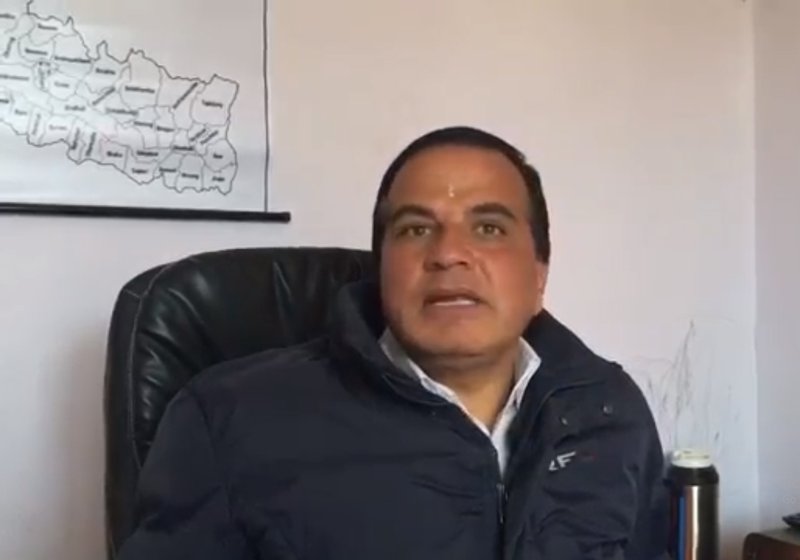
He agreed that NGOs and INGOs have limitations as they cannot spend Rs.350, 000.00 as per the regulations. However, they can build even four-room houses asking for contribution from the local communities.”
“The government has been repeatedly saying that Rs.300, 000.00 is given just to build earthquake resilent houses. If house owners want to build four room houses, they can build these with additional money as necessary. The only question is that the house should be built as per the guidelines of NRA,” said Acharya.
Looking at the latest condition of Dolakha District, most of the earthquake victims are building two-room houses because they don’t have the additional money. There is a misperception about the grant. Many victims think that the grant money is to build the two room houses.
After receiving the grant money, Ganesh Bahadur Shrestha of Lakuri Danda is also building a two-room house. Shrestha’s understanding is that under a private housing grant, he can build only a two-room house.
According to National Reconstruction Authority District Unit, the progress of private construction is satisfactory. Many buildings are under construction and the number of beneficiaries taking the grants has drastically increased.
However, the rural populations have their own difficulties. There is confusion in the rural areas whether they are building earthquake resilient houses or two-room houses. Under the supervisions of engineers and approved design of Department of Urban Development Building Construction, people are building the houses. According to the catalogue, the earthquake victims can build one room or two room houses. The second part of the catalogue also approves alternative technology to build the houses. However, victims will receive the grant only when the buildings follow the National Building Codes.
Although there are dozens of organizations working in reconstruction in Dolakha, there were only a few reconstructed houses with Nepalese structures. Majority of the houses under construction are two-room houses. The two-room houses are inadequate in the rural structures with cattle shed, bee hive or chicken cage, forget about the balcony.
Victims complain that the designs are not in tune with their livelihood. Old people have their own worries. Sixty one years old Chasman Tamang complains that the government is blurring the lines of old Nepalese style in the name of new earthquake resilient houses.
“The NRA approved building design undermines the old culture and agriculture based lifestyle. I think the new buildings will be resilient to earthquakes. However, they bury and dismantle our own cultures and values.”
In the name of building earthquake resilient houses, people are building houses, which are insufficient and unable to meet their own needs. “We are giving up our rich construction costumes, culture and style, forgetting our own materials and creativity in the name of earthquake resilient houses like doll. NRA’s present guidelines compel people to build the house as per their own design,” said Tamang.
Although the government has constituted NRA to speed up reconstruction systematically with necessary rules and regulations, collect the donor’s contributions, design various building structures and assign engineers in the villages, the speed of initial period was slow.
Now many masons are receiving 7 to 45 days of training and donors from all over the world are supporting the reconstruction process. However, Nepal’s own culture and technology is going beneath these resilient structures.
According to the data of Urban Development Building Construction, District Office Dolakha, 15000 houses have already been constructed in Dolakha and 21000 are in the process of reconstruction, 16300 beneficiaries have already received second installment and 4517 have received the third installment.
Out of them 1500 beneficiaries have received the second installment and 1000 received the third instilment from donors.
According to the Urban Development and Building Construction, District Office, five international non-government organizations have been building 2289 houses in the district. Those include The Save the Children 549, CARITAS 1335, SOS Children 108 and HURADEC 297.
Government officials claim that those houses built under the grant are all earthquake resilient but they have only two rooms. Adhikary, head of Urban Development and Building Construction Division, is also not happy with the design.
“During the initial days, our concern was how to build the houses for the victims and to distribute the grant easily. Of course, the beneficiaries are raising the voices on the reconstruction but no one is listening. Instead of building one house to show to the government and another for living, I would like to request all beneficiaries to build their houses as per their need following the guidelines for earthquake resilience.” Adhikary also holds the view that the organizations working in the districts do not have the coordination with the local level. Most of the organizations are coming to the district for signing agreements with the center. He said that the NGOs and INGOs chose the areas connected to the roads and nobody went to remote parts of the country.
Central advisor of SOS Children and Reconstruction in charge Shanker Pradhanang said, “We have to construct the buildings strictly following the guidelines and agreement. NRA allows us just 350,000.00 per family. “You cannot make houses spending such a small amount of money. We have already handed over 108 homes in Lakuri danda,” said Pradhanang.
Other non-government organizations also complain about the process to get the permission and ceiling set for the reconstruction. “It took us 17 months to secure the permission and two months for training. We chose the houses under the design provided by NRA. Initially, our plan was to construct four room homes. However, the money available with us was inadequate to do so. Our aim is to hand over earthquake resilient houses to beneficiaries even if it is just two rooms. In some places, the beneficiaries do not have adequate land to build a two-room house,” said Pradhanang.
Although the earthquake gave a good opportunity to build organized urban areas and earthquake resilient houses, the ongoing reconstruction process shows something else happening. As Nepal’s reconstruction process has passed through a period of intense political instability, it has left many lacunas behind.
Despite making progress and working to heal the wounds of earthquake victims, there are still a lot of things to do in the district. Looking through the eyes of the victims, Nepal’s ongoing reconstruction process is too little and too official oriented.
This publication has been supported by The Asia Foundation. The contents of this publication reflect the views of the author(s), researcher(s), and contributing editor(s) and do not necessarily reflect the views of The Asia Foundation.
PDF Pages New Spotlight Investigation

Temporary Shelter
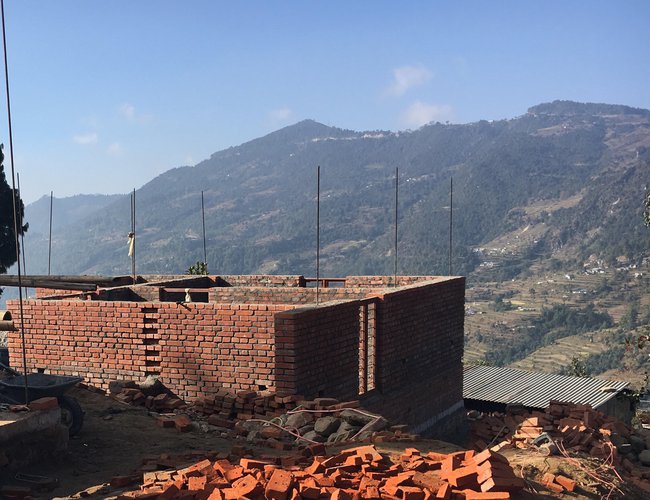
Building under Reconstruction
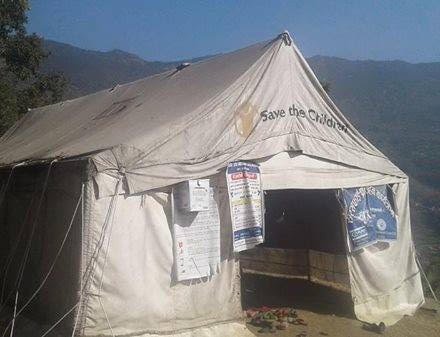
Temporary school
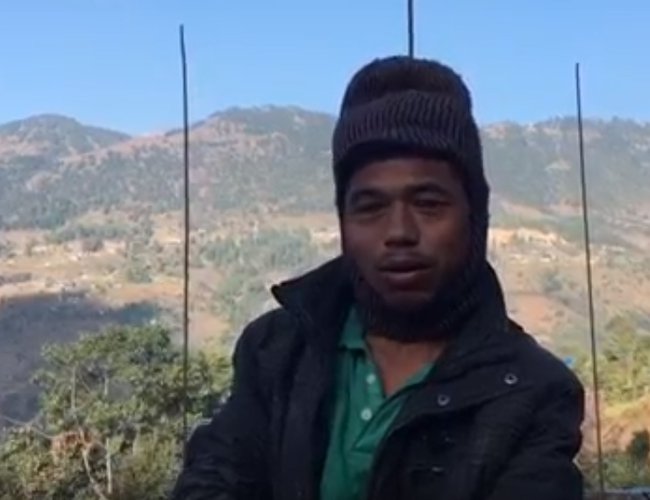
Victim Shrestha
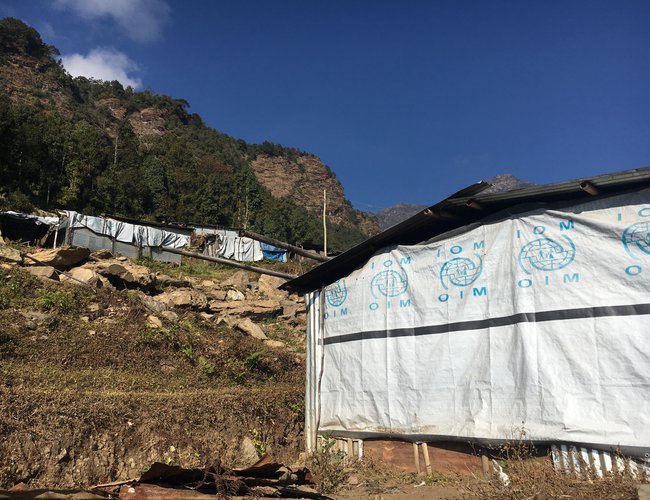
Temporary shelters

Nirashi Thami
Journalist based in Charikot covering various contemporary issues.
- IMPACTS OF EARTHQUAKE DEBRIS Charikot Trouble
- Oct 27, 2017
